
MOS 0335 is the United States Marine Corps (USMC) Military Occupational Specialty (MOS) code for infantry rifleman. It is the primary infantry MOS for enlisted Marines.

MOS 0335 is the United States Marine Corps (USMC) Military Occupational Specialty (MOS) code for infantry rifleman. It is the primary infantry MOS for enlisted Marines.
A rifleman may employ the M4 carbine, the M203 grenade launcher, the M27 Infantry Automatic Rifle, AT4 and M72 LAW rockets. Riflemen are the primary scouts, assault troops, and close combat forces available to the Marine Air Ground Task Force. They are the foundation of the Marine infantry organization, and as such are the nucleus of the fire team in the rifle squad, the scout team in the LAR squad, scout snipers in the infantry battalion, and reconnaissance or assault team in the reconnaissance units. Noncommissioned officers are assigned as fire team leaders, scout team leaders, rifle squad leaders, or rifle platoon guides. The mission of the Marine Corps rifle squad is to locate, close with and destroy the enemy by fire and maneuver or to repel the enemy's assault by fire and close combat.
Training for this MOS is conducted at the United States Marine Corps School of Infantry located at Camp Geiger, North Carolina or Camp Pendleton, California. The training period is 59 days.
A company is a military unit, typically consisting of 100–250 soldiers and usually commanded by a major or a captain. Most companies are formed of three to seven platoons, although the exact number may vary by country, unit type, and structure.
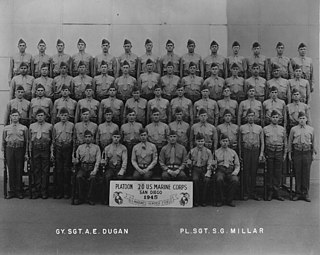
A platoon is a military unit typically composed of two to four squads, sections, or patrols. Platoon organization varies depending on the country and the branch, but a platoon can be composed of 20–50 troops, although specific platoons may range from 10 to 100 people. A platoon is typically the smallest military unit led by a commissioned officer. The platoon leader is usually a junior officer—a second or first lieutenant or an equivalent rank. The officer is usually assisted by a platoon sergeant.
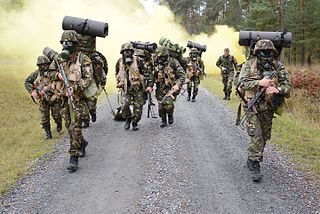
In military terminology, a squad is among the smallest of military organizations and is led by a non-commissioned officer. NATO and U.S. doctrine define a squad as an organization "larger than a team, but smaller than a section." while U.S. Army doctrine further defines a squad as a "small military unit typically containing two or more fire teams." In American usage, a squad consists of eight to fourteen soldiers, and may be further subdivided into fireteams.

A fireteam or fire team is a small modern military subordinated element of infantry designed to optimize "NCO initiative", "combined arms", "bounding overwatch" and "fire and movement" tactical doctrine in combat. Depending on mission requirements, a typical "standard" fireteam consists of four or fewer members: an automatic rifleman, a grenadier, a rifleman, and a designated fireteam leader. The role of each fireteam leader is to ensure that the fireteam operates as a cohesive unit. Two or three fireteams are organized into a section or squad in co-ordinated operations, which is led by a squad leader.

Force Reconnaissance (FORECON) are United States Marine Corps deep reconnaissance companies that supply military intelligence to the command element of the Marine Air-Ground Task Force (MAGTF). Force Reconnaissance companies unlike USMC division reconnaissance report to the Marine expeditionary force (MEF) and provide direct action and deep reconnaissance during large-scale operations.
The School of Infantry (SOI) is the second stage of initial military training for enlisted United States Marines after recruit training. The ITB now called IMC went from a 59 day course to 14 week course. Since the initial training pipeline is divided between coasts, Marines from areas east of the Mississippi River usually graduate from MCRD Parris Island and move on to SOI at SOI East, while those from the western half of the nation attend MCRD San Diego and move on to SOI West at the Camp San Onofre area of Camp Pendleton in California. Female Marines are trained at both SOI East and SOI West. The School of Infantry's training mission ensures "Every Marine is, first and foremost, a Rifleman". At SOI, Marines with the Military Occupational Specialty of infantry are trained at the Infantry Training Battalion (ITB), while all non-infantry Marines are trained in basic infantry and combat skills at the Marine Combat Training Battalion. SOI marks a transition in the professional training of entry-level students from basically trained Marines to combat-ready Marines.

The Basic School (TBS) is where all newly commissioned and appointed United States Marine Corps officers are taught the basics of being an "Officer of Marines." The Basic School is located in Stafford County, Virginia to the south-west of the Marine Corps Base Quantico complex. Each year, over 1,700 new officers are trained, representing such commissioning sources as the U.S. Naval Academy, Navy ROTC, Officer Candidates School, and Marine Corps Limited Duty Officer (LDO) and Warrant Officer, U.S. Merchant Marine Academy accession programs.

United States Marine Corps Scout Sniper was a secondary MOS designator of U.S. Marine Corps infantrymen and reconnaissance Marines that have graduated from a U.S. Marine Corps Scout Sniper School. Scout Snipers must earn the rank of Lance Corporal, be selected by their battalion to join the scout-sniper platoon, and complete an approved scout-sniper course in order to receive this designation. As of December 2023, Marine scout snipers have been reorganized as MOS 0322 Reconnaissance Sniper Marines, as part of a 26-Marine Scout Platoon.

A rifleman is an infantry soldier armed with a rifled long gun. Although the rifleman role had its origin with 16th century hand cannoneers and 17th century musketeers, the term originated in the 18th century with the introduction of the rifled musket. By the mid-19th century, entire regiments of riflemen were formed and became the mainstay of all standard infantry, and rifleman became a generic term for any common infantryman.

2nd Light Armored Reconnaissance Battalion is a fast and mobilized armored terrestrial reconnaissance battalion of the United States Marine Corps. Their primary weapon system is the 8-wheeled LAV-25 and they fall under the command of the 2nd Marine Division and II Marine Expeditionary Force. The unit is based out of the Marine Corps Base Camp Lejeune, North Carolina. The current mission statement of the battalion is: To perform combined arms reconnaissance and security missions in support of the Ground Combat Element (GCE) of a Marine Air-Ground Task Force (MAGTF). Its mission is to conduct reconnaissance, security and economy of force operations, and, within its capabilities, limited offensive or defensive operations that exploit the unit's mobility and firepower.
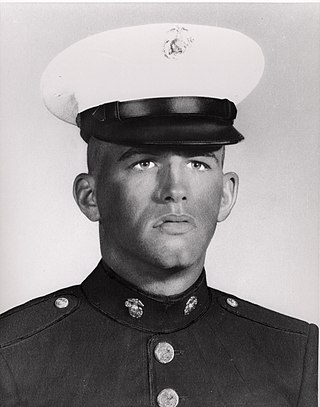
Lance Corporal Richard Allen Anderson was a United States Marine who was posthumously awarded the Medal of Honor for his heroic actions above and beyond the call of duty in August 1969 during the Vietnam War.

Larry Leonard Maxam was a United States Marine who posthumously received the United States' highest military honor — the Medal of Honor — for heroism in the Vietnam War in February 1968,

The United States Marine Corps is organized within the Department of the Navy, which is led by the Secretary of the Navy (SECNAV). The most senior Marine commissioned officer is the Commandant of the Marine Corps, responsible for organizing, recruiting, training, and equipping the Marine Corps so that it is ready for operation under the command of the unified combatant commanders. The Marine Corps is organized into four principal subdivisions: Headquarters Marine Corps, the Operating Forces, the Supporting Establishment, and the Marine Forces Reserve.
MOS 0369 is the United States Marine Corps (USMC) Military Occupational Specialty (MOS) for Infantry Unit Leader.
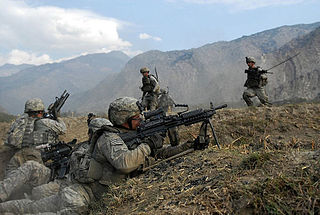
Small unit tactics is the application of US Army military doctrine for the combat deployment of platoons and smaller units in a particular strategic and logistic environment. The composition of a United States Army squad falls into three broad categories: classical, balanced and combined.
In the United States Marine Corps, the ground combat element (GCE) is the land force of a Marine Air-Ground Task Force (MAGTF). It provides power projection and force for the MAGTF.

The M27 Infantry Automatic Rifle (IAR) is a 5.56mm, select-fire assault rifle, based on the HK416 by Heckler & Koch. It is used by the United States Marine Corps (USMC) and is intended to be issued to all infantry riflemen as well as automatic riflemen. The USMC initially planned to purchase 6,500 M27s to replace a portion of the M249 light machine guns employed by automatic riflemen within Infantry and Light Armored Reconnaissance Battalions. Approximately 8,000–10,000 M249s will remain in service with the Marine Corps to be used at the discretion of company commanders. In December 2017, the Marine Corps announced that it would equip every member of an infantry squad with the M27, supplanting the M4 carbine which would be retained at the platoon leadership positions and above.
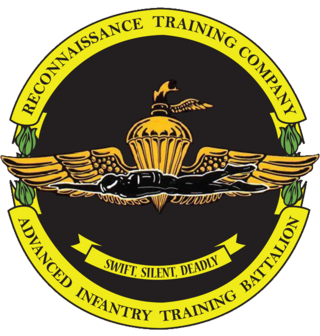
The two amphibious/ground reconnaissance assets of the United States Marine Corps, Division and Force Reconnaissance, are generally trained in the same aspect and environment of intelligence collection for a Marine Air Ground Task Force (MAGTF) Commander, regardless of their difference in tactical area of responsibility (TAOR). However, in light of their distinctive responsibilities in their assigned areas of operations—whereas Division Recon conducts close and distant operations, Force Recon conducts deep operations—these two separate reconnaissance assets manage their own training protocols to fit their mission-oriented objectives.
Ground Intelligence Officer is a primary military occupation code of a U.S. Marine Corps intelligence officer. Ground intelligence officers serve as staff officers and commanders in the operating forces and are responsible for analyzing intelligence and planning, deployment and tactical employment of ground surveillance and reconnaissance units. The Ground Intelligence Officer can be a Recon Marine after their training is done.